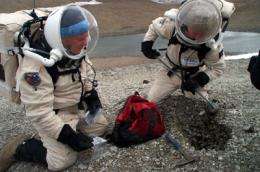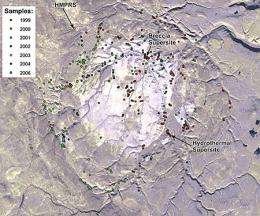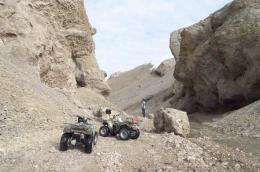Planning Our Phases on the Moon

As space agencies around the world gear up for a return of humans to the Moon, researchers are beginning to outline important scientific priorities. A new study at an impact crater in Canada is helping mission planners develop the most effective methods for exploring the lunar surface.
Space agencies around the world have been gearing up for the return of human explorers to the Moon by developing fantastic new technologies. From rovers to rockets, these technologies are necessary for transporting astronauts to the Moon and for performing surface geology and biology experiments. As the prospect of a renewed human presence on the Moon approaches, it may be time to think about how our scientific priorities at the Moon will best be achieved.
These are the issues being discussed by a group of researchers working in the Canadian Arctic. The team recently published a study in the journal Planetary and Space Science about the lessons they have learned while performing field science in an impact crater - and how these lessons could be used to provide guidelines for humans working on the lunar surface.
The Canadian Side of the Moon
The Haughton impact structure is located on Devon Island in Canada's Nunavut Territory. Haughton is the only crater known on Earth that lies in the polar desert. Its frigid, high arctic environment has made it a hot destination for space scientists wanting to try out the latest fashions in spacesuit design and exploration technology.
Since 1997, scientists have regularly used the site to test equipment and perform detailed geological and biological studies. Haughton is also the location of the Flashline Mars Arctic Research Station, where crews simulate living and working in a model martian habitat.
The only direct experience we have in human surface operations on the Moon comes from the six Apollo lunar landings. These missions provided valuable experience, but a lot has changed since the last Apollo landing in 1972. The instruments that scientists are now able to take into the field are much smaller and more powerful. Future explorers will also spend far more time on the Moon. NASA hopes to achieve regular missions of 180 days in length. This means that future lunar explorers have the potential to perform much more complicated and detailed science investigations. Because impact craters are a dominant feature of the lunar landscape, locations like the Haughton impact structure are essential practice sites for expanding our knowledge of how surface exploration will best be conducted by astronauts on the Moon.
The authors of the recent study spent five successive field seasons systematically exploring Haughton crater. They visited sites throughout the crater by simulating extra-vehicular activity (EVA), and collected numerous samples, photographs and other scientific data. Each excursion was planned using remote sensing data to identify points of interest. The resolution of remote data was not fine enough to identify specific outcrops and structures of the crater in small scale. Instead, remote images helped identify large-scale features, such as drainage patterns, and potential obstructions, such as steep cliff walls. This proved to be a good analog for lunar exploration, where data from remote sensing will be used to define general areas for exploration, while the small-scale points of interest will be discovered and sampled by astronauts as they traverse the surface.
According to lead author, Gordon Osinski, "Many of the high priority scientific questions driving lunar exploration require samples to be brought back to Earth. We absolutely have to conduct surface science to collect these samples and understand their context if the laboratory work on Earth is to mean anything."

Phases of Lunar Exploration
In order to determine the most efficient way to carry out science on the lunar surface, the researchers turned to their knowledge of scientific methods practiced by field geologists on Earth. From this perspective, human exploration of the Moon can be broken down into three phases.
1. Lunar Recon
First comes reconnaissance. This initial phase uses remote sensing and topographic data to identify potential regions of scientific interest, saving time and resources. The expense of getting to the Moon and the danger involved mean that astronauts can't just simply go for a walk in the hopes they’ll come across something interesting.
For the Haughton study, this phase raised more questions than answers. "This is very much how exploration and field geology work," says Dr. Osinski. "You often go into the field for the first time with some very simple hypotheses. Unexpected discoveries often result in new questions. In fact, you could say that the reconnaissance phase is all about finding out what we don’t know about a region, so that we can focus the subsequent systematic work on answering the really important questions."
The researchers found that one of the most important aspects of the reconnaissance phase is flexibility, and cite an example from their work in Haughton:
"During the final days of the 1999 field season, the lead author (Gordon R. Osinski) was on a long regional traverse exploring the southern part of the Haughton River valley and discovered an outcrop displaying intense alteration by secondary minerals… These minerals were only present on a fresh vertical outcrop that was not observable on any remote sensing dataset." the authors of the study report.
Planning ahead for exploration using remote sensing data is important - but if explorers happen upon sites of specific interest, it is also important that they are able to change their plans to take advantage of their findings. This is an important consideration for the Moon, where flexibility will be limited by the equipment and resources (such as oxygen) that astronauts are able to carry into the field.
Barring any special, unexpected finds, the main goal of collecting samples during the reconnaissance phase is to simply get a general representation of the types of geological material present in the area. This allows geologists to identify key 'science supersites' that warrant more visits.
2. Systematic Sampling
The second phase is systematic region-scale mapping and sampling. After gaining a general familiarity with the region and examining a broad collection of samples, astronauts will then have a better idea of specific sites that need to be revisited for further study. Another important part of this phase is to develop systematic and detailed geological maps. These maps are more detailed than those produced by remote sensing, and are essential for placing any scientific findings in the true context of their surroundings.
According to the authors of the study, "It will only be through detailed mapping that we can be sure, for example, that a collected sample is from the ejecta of the target crater and not from another distal basin-forming impact."
The end goal of phase two is a systematic and more detailed understanding of the region. This means that more data and samples will be collected than was gathered during the reconnaissance phase. Because of this, astronauts will need more supplies, equipment and sample storage facilities.
3. Getting Local
The final phase of surface operations on the Moon is detailed local-scale mapping and sampling. During this phase, astronauts will concentrate on return visits to key sites where they will collect specific samples and perform detailed research.
"One of the major obstacles to conducting geology on the Moon is the rarity of 'outcrops' - rocks that are in place and undisturbed," according to Dr. Osinski. "Much of the Moon’s surface is regolith and material thrown out by impact craters, which makes knowing where a particular rock came from very difficult. Places where outcrops occur, such as on the walls of steep canyons or in small, fresh impact craters, will be some of the high priority sites."
During phase three, astronauts will spend less time traveling and more time collecting data. According to the authors, "There is a greater emphasis during this phase on formulating scientific questions before the field season and detailed planning of traverses." This includes careful planning of routes to reduce travel times and maximize the amount of time that explorers can spend at major points of interest.

From Haughton to the Moon
Through their experiences exploring Haughton crater, the research team developed a list of lessons for mission planners working on lunar exploration. First, mission planning must allow for flexibility in order to take advantage of serendipitous discoveries. This may be the most important recommendation resulting from the Haughton study. Interviews with Apollo astronauts also highlighted the need for flexibility on future lunar missions.
According the authors, "it was suggested that the crew should play a far more active role in planning and executing their activities and that these missions should not be as tightly scheduled as Apollo." Interaction between the crew and Earth-based support is still important, but "interaction with a ground advisor should be very much on a 'crew request' basis and not the other way around."
Lunar explorers will also require a rugged but simple human operated rover. The work in Haughton crater indicates this is an essential piece of equipment. Multiple rovers may be needed for redundancy, and would allow explorers to safely travel farther from the habitat. Remote 'field camps' could also increase the distance at which EVAs could be taken. These would provide a place for explorers to replenish supplies, such as water and oxygen, when they are running low and are too far from the habitat to make it home safely.
The lessons learned from Haughton also provide insight into requirements for lunar habitats. Explorers on the Moon will need sufficient laboratory space inside the habitat so that they can easily interact with and study samples. Adequate space must also be set aside for storing samples, both in the habitat and on the rovers. Finally, a 'sample shed' will be required so that scientists have a place where they can screen samples and prioritize them for further study in the laboratory.
"Some field geologists may consider many of these finding to be unsurprising or 'common sense'; however, we believe that this kind of study is important to inform mission planning," the authors write. "By conducting science in an analog environment on Earth, we can learn how to conduct fieldwork beyond the Earth."
More information: Reference: Gordon R. Osinski et al. (2009) "Field geology on the Moon: Some lessons learned from the exploration of the Haughton impact structure, Devon Island, Canadian High Arctic", Planetary and Space Science
Source: Astrobio.net, by Aaron L. Gronstal



















